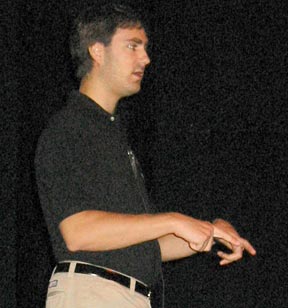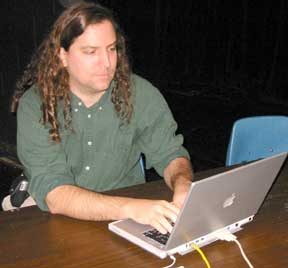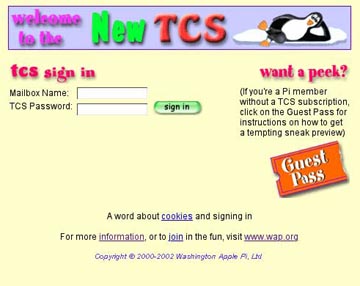



There was something old and something new at the Pi’s September 2002 General Meeting. For two decades, the Pi’s famed computer bulletin board, the TCS, has been hosted on Apple II computers. In the beginning, these were Apple II+ computers running a commercial bulletin board package allowing one caller at a time to dial in via the bulletin board’s blazing-fast 1200 bps modem and post messages. Later, this evolved into a room full of Apple IIGS computers sharing a bank of modems and a massive 100 megabytes or so (sometimes less, sometimes more) of shared messages and files.

The meeting opened with Craig Contardi, Pi Secretary, fielding general questions from the audience on all things Macintosh. (Photo by Lawrence I. Charters)
But by the end of 2002 the Apple IIs will be retired. All the work formerly done by as many as 18 Apple IIs will be handled by a singe Macintosh Mac OS X 10.2 machine running a custom-written WebObjects bulletin-board application written by Jon Thomason, the Pi’s telecommunications architect.
The September meeting was a public demonstration of the new bulletin board system (which has actually been in operation for many months) as well as the Pi’s new, expanded E-mail system. The meeting began with a little history, talking about the early days of the TCS when “multi-user” meant dialing two different phone numbers to reach different parts of the bulletin board. A few years later Pi volunteers figured out a way to use a shared hard drive originally intended for classrooms as the basis of a shared storage for a multi-line TCS, with an Apple II computer and a modem dedicated to every phone line.
By coincidence, the 100,000th caller to the TCS was a 14 year old Bethesda boy with an interest in programming. The TCS Committee offered him a tour of the bulletin board as a prize for this momentous event, and Jon Thomason (now somewhat older than 14) has been part of the TCS family ever since. Within a few years Jon had rewritten the TCS software in a mix of AppleSoft BASIC and 6502 machine language, greatly expanding the number of topic areas offered, the speed of supported modems (up to 14,400 bps!), and the general robustness of the system.

Jon Thomason, telecommunications architect for Washington Apple Pi, “drove” a PowerBook G4 attached to a digital projector to demonstrate the TCS. (Photo by Lawrence I. Charters)
Hosting the tour of the “new” TCS was the 500,000th caller, Lawrence Charters. Lawrence has served as the Pi’s Webmaster since the Pi first put up a Web server, and has been actively involved in the TCS since moving to the East Coast in 1991. It isn’t entirely clear how many calls have come in since then, but Jon Thomason estimates we’ve had well over a million calls on the Apple II-based system.
Among the TCS firsts:
Most of the meeting was devoted to demonstrating how to log into the TCS, how to get help (you can view the online help, without logging in, by going to http://www.wap.org/tcs/), how to set preferences, how to read and respond to messages, and other common activities. The older, text-based version of the TCS tended to intimidate new users, but the audience seemed nothing less than delighted with the new, Web-based graphical user interface.

The Pi’s Web-enabled computer bulletin board, the TCS, is available to all current Pi members. Log in and be part of the Pi’s 24-hour “General Meeting,” with round-the-clock discussions on computers, politics, jokes, and countless other topics.
The last portion of the meeting was devoted to a demonstration of the Pi’s new E-mail system, in operation not quite a week. The old system, while quite reliable, was showing definite signs of age: it was based on freeware software, hosted on a surplus Power Mac running Mac OS 9, with all files stored on a single, overcrowded 4 gigabyte drive. Maintaining E-mail accounts was an awkward process involving too many people, and some services, such as Web-based mail checking, were not possible.
In contrast, the new server is a model of modernity, robustness and flexibility. Based on Stalker Software’s near-legendary Communigate Pro package (see http://www.stalker.com), it supports SMTP, http, https, POP3, IMAP, and many other combinations of letters and numbers. For the first time, Pi members can now go into a public library or cyber café, or a friend’s home, and using just a simple Web browser can check their E-mail.
Much of the presentation was devoted to Apple’s Mail application, bundled with Mac OS X 10.2. While the Mail application was demonstrated at both the July and August General Meetings, this time around the demonstration featured a live Internet connection, and live mail. The audience got to see Mail’s Spam filter in action, as well as see how it handles HTML-based “enhanced” mail, PDF files, JPEG graphics, and various other odd things. Sadly, Mail is not “virus enabled,” so it lacks any native capability to send virus-infected E-mail to everyone in your address book. For that, you’ll have to look elsewhere…